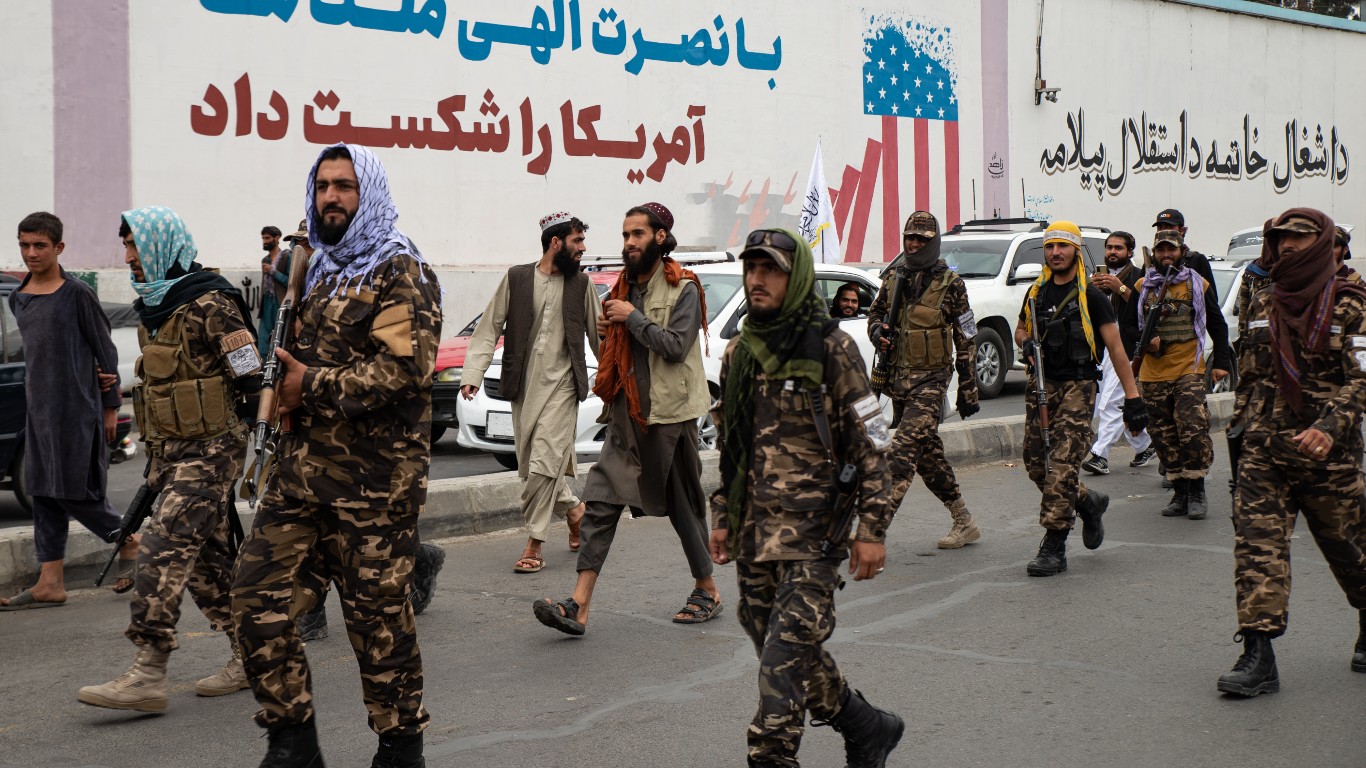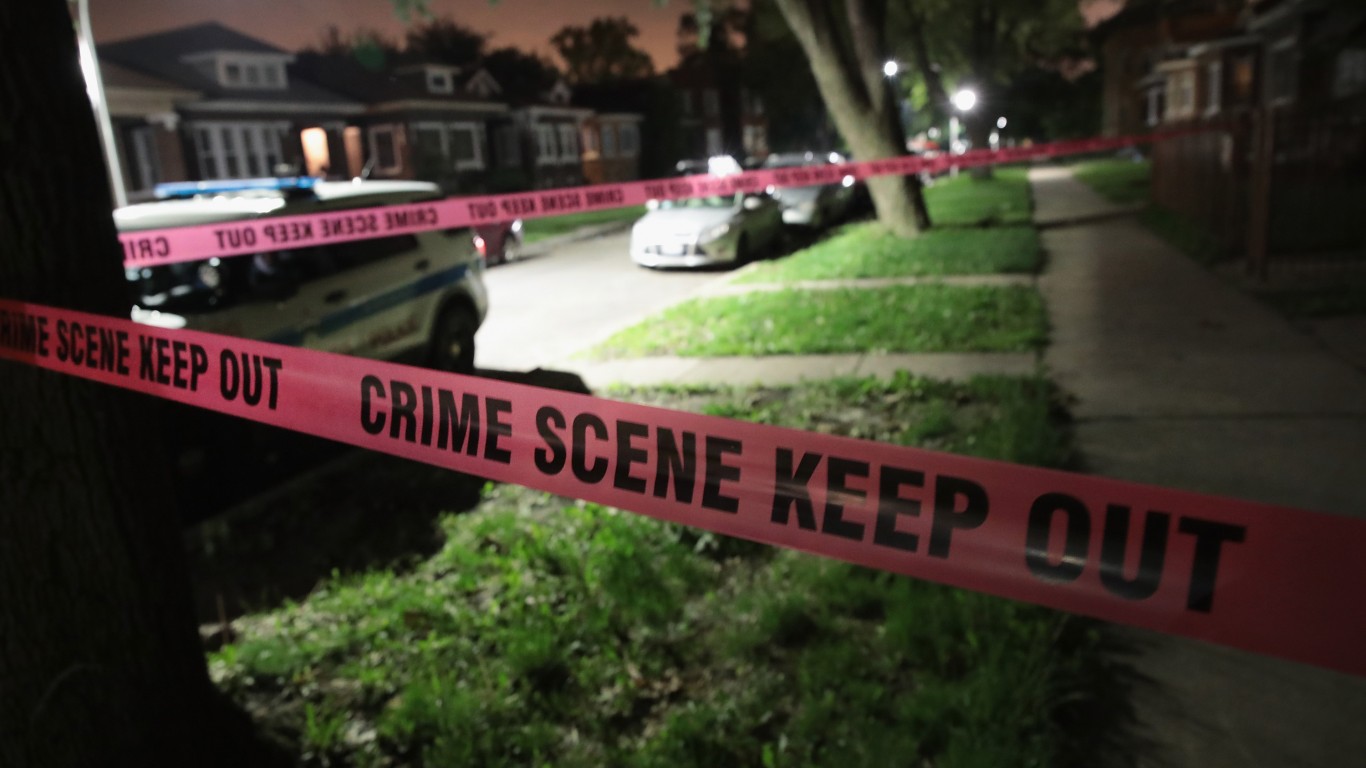
Cities across the United States are reporting a spike in gun violence and homicide during the COVID-19 pandemic. In the first six months of 2020, there was a nearly 15% increase in murders nationwide, and across a sample of 59 cities tracked by the FBI, the number of murders was up 28% from January through July compared to the same period in 2019.
The increase reflects a sudden reversal of a long-term trend, as violent crime has fallen in the U.S. for four consecutive years. In 2019, there were 367 violent crimes reported for every 100,000 people in the United States, a low not seen since 2014 and a far cry from the highs of the early 1990s that topped 750 violent crimes per 100,000 people annually.
While a complete picture of the incidence of violence in the United States in 2020 remains to be seen, there are dozens of cities across the country that were already plagued by violence before this turbulent year.
24/7 Wall St. reviewed violent crime rates in the 295 U.S. cities tracked by the FBI that are home to at least 100,000 people to determine the 25 most dangerous cities in America. Violent crime rates are population-adjusted figures calculated using the number of rapes, robberies, aggravated assaults, and homicides committed in 2019 per 100,000 people.
Violent crime is a difficult social phenomenon to explain. Certain factors, however, may affect the incidence of violence, especially employment. Higher employment rates among at-risk groups have been shown to reduce the likelihood of violent crime — and some experts are pointing to the ongoing unemployment crisis to help explain the current surge in violence nationwide. Indeed, many of the cities on this list were struggling with widespread joblessness even before the COVID-19 recession. Here is a look at the cities with the worst COVID-19 unemployment crisis right now.
The relationship between income and crime is complicated, but cities with high poverty also often have higher crime rates. In the vast majority of cities on this list, the poverty rate exceeds the comparable 14.1% national rate. Here is a list of America’s poorest cities.
Click here to see the 25 most dangerous cities in America.
Click here to read our detailed methodology.

25. Odessa, Texas
> Violent crime rate in 2019: 1,038 per 100,000 people (1,282 total)
> Total homicides reported in 2019: 13
> 2019 poverty rate: 10.7%
> 2019 annual unemployment rate: 2.5%
> 2019 population: 123,468
Odessa in West Texas ranks as one of the most dangerous cities in America, with a violent crime rate of 1,038 incidents per 100,000 residents, according to the FBI’s 2019 Uniform Crime Report. This is well beyond the U.S. violent crime rate of 367 incidents per 100,000 people.
Odessa has higher than typical rates of all four different types of violent crime — murder, rape, robbery, and aggravated assault. The bulk of violent crimes in Odessa are aggravated assaults, as is the case in most cities. Odessa has the 19th highest aggravated assault rate, with 810 reported assaults per 100,000. The nationwide rate of aggravated assault is 250 per 100,000.
[in-text-ad]
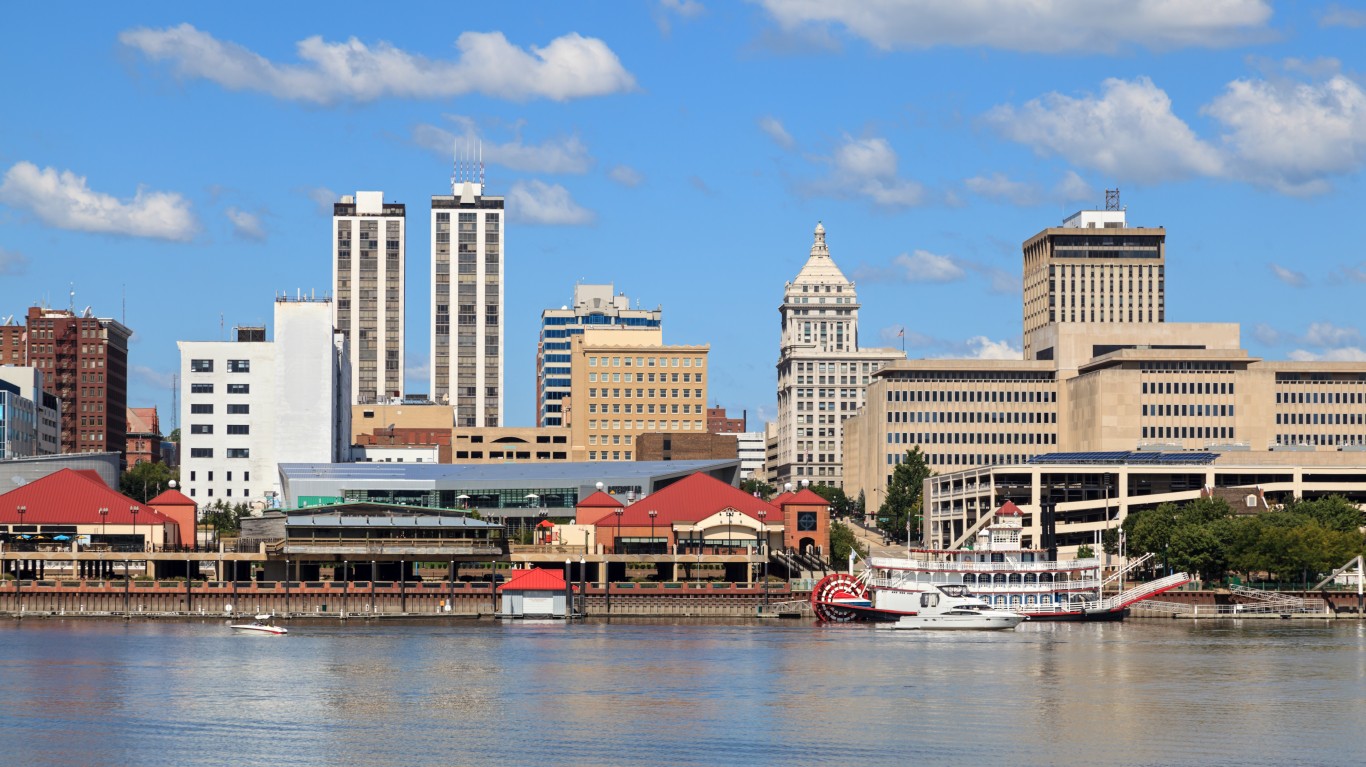
24. Peoria, Illinois
> Violent crime rate in 2019: 1,044 per 100,000 people (1,158 total)
> Total homicides reported in 2019: 25
> 2019 poverty rate: 20.7%
> 2019 annual unemployment rate: 5.3%
> 2019 population: 110,955
Peoria, Illinois, has one of the highest violent crime rates in the country, with 1,044 reported violent crimes for every 100,000 people in 2019. It also has the 15th highest murder rate among large U.S. cities, with 23 homicides per 100,000 residents. Nationwide, the murder rate is 5 per 100,000.
Areas with higher rates of violent crime tend to also face other challenges, such as low incomes, as well as high poverty and unemployment rates. More than one out of every five Peoria residents live below the poverty line, well above the national 14.1% poverty rate.
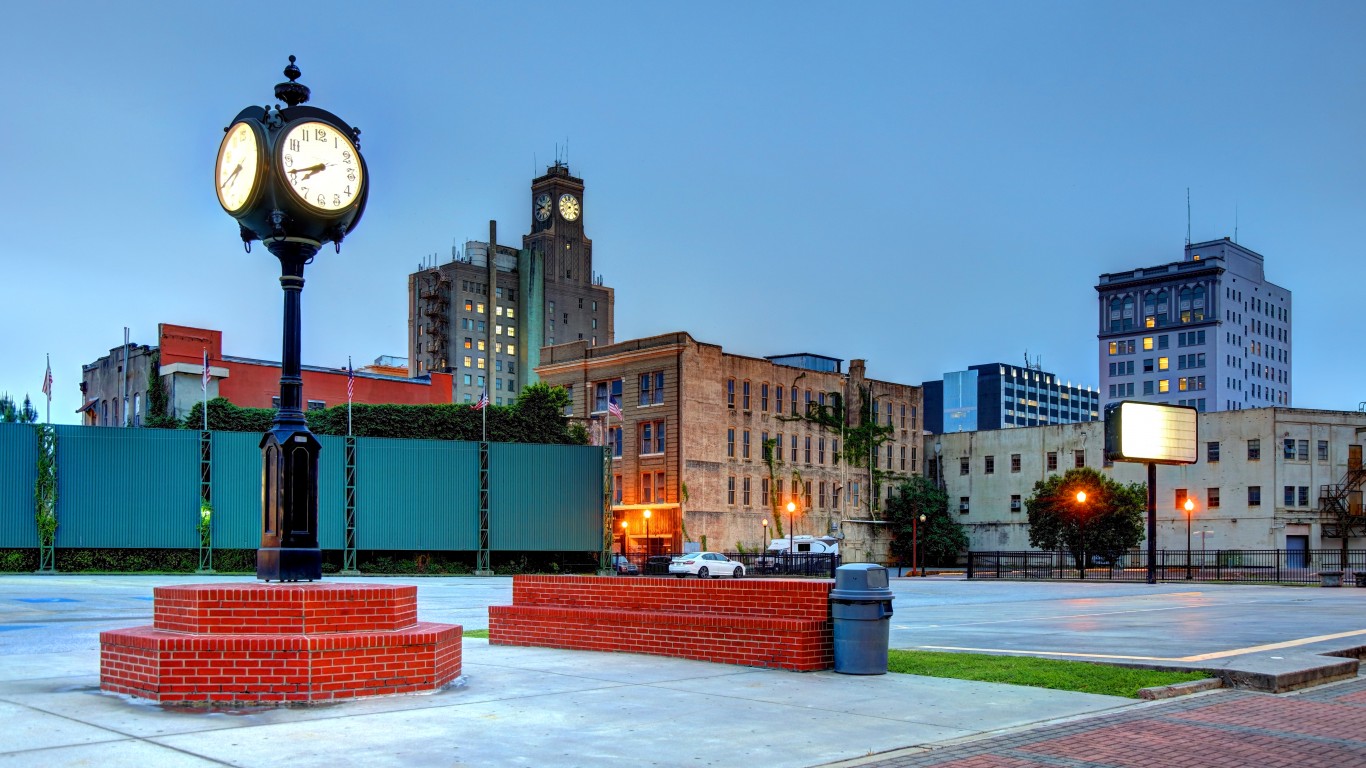
23. Beaumont, Texas
> Violent crime rate in 2019: 1,047 per 100,000 people (1,241 total)
> Total homicides reported in 2019: 19
> 2019 poverty rate: 19.9%
> 2019 annual unemployment rate: 5.2%
> 2019 population: 118,562
Beaumont is one of three Texas cities to rank among the 25 most dangerous in America. In 2019, there were 19 homicides reported in the city, equating to 16 murders per 100,000 residents — more than triple the U.S. murder rate. Beaumont’s robbery rate of 272 incidents per 100,000 people is also more than three times higher than the U.S. robbery rate.

22. Chattanooga, Tennessee
> Violent crime rate in 2019: 1,070 per 100,000 people (1,946 total)
> Total homicides reported in 2019: 33
> 2019 poverty rate: 18.8%
> 2019 annual unemployment rate: 3.6%
> 2019 population: 181,848
There were 1,946 violent crimes reported in Chattanooga in 2019, or 1,070 incidents per 100,000 residents. The vast majority of these crimes were aggravated assaults. There were 856 reported assaults per 100,000 residents. In addition to having one of the highest violent crime rates in the country, Chattanooga also has one of the 10 highest property crime rates, at 5,557 per 100,000. Nationwide, there were 2,110 property crimes reported per 100,000 people.
[in-text-ad-2]
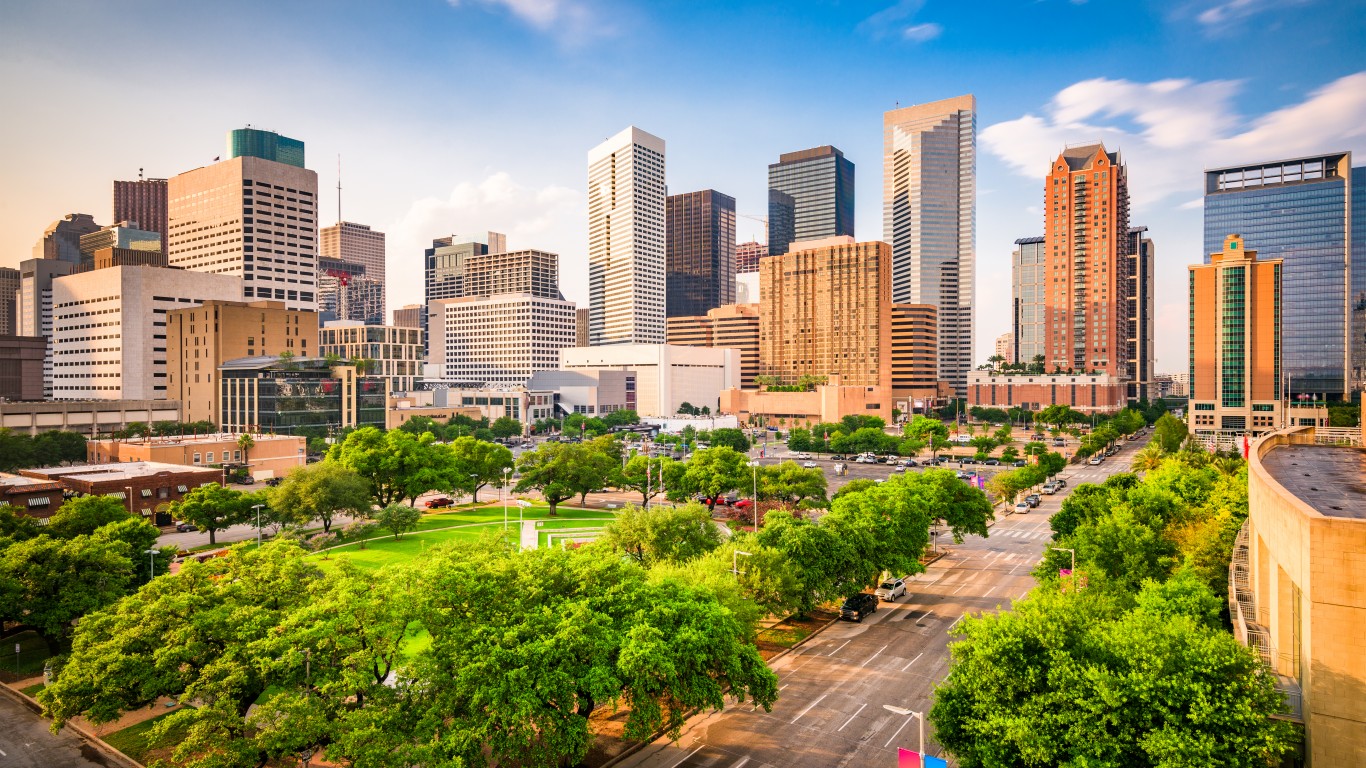
21. Houston, Texas
> Violent crime rate in 2019: 1,072 per 100,000 people (25,257 total)
> Total homicides reported in 2019: 275
> 2019 poverty rate: 20.6%
> 2019 annual unemployment rate: 3.7%
> 2019 population: 2,355,606
With a population over 2.3 million people, Houston is by far the largest city to rank among the 25 most dangerous. The city reported 275 homicides in 2019, or a murder rate of 12 per 100,000 residents — more than double the national murder date of 5 incidents per 100,000 people. Houston also reported the sixth highest rate of robbery of any large U.S. city, with 388 incidents per 100,000 residents. Nationwide, there were 82 robberies per 100,000 residents.
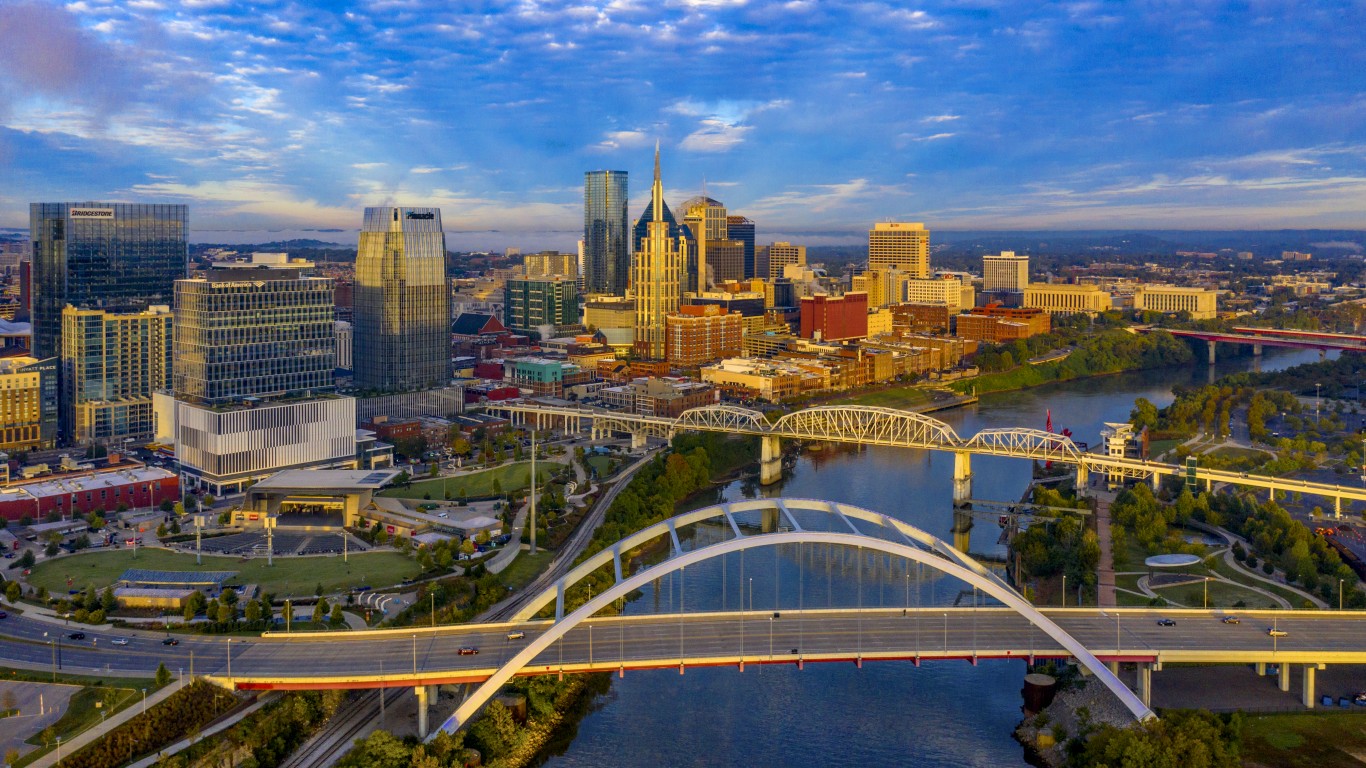
20. Nashville, Tennessee
> Violent crime rate in 2019: 1,073 per 100,000 people (7,376 total)
> Total homicides reported in 2019: 83
> 2019 poverty rate: 16.5%
> 2019 annual unemployment rate: 3.9%
> 2019 population: 687,361
Nashville is one of just 26 major cities in the U.S. out of nearly 300 to report a violent crime rate of over 1,000 incidents per 100,000 residents in 2019. For context, the U.S. violent crime rate is 367 per 100,000. Nashville also reported 12 homicides per 100,000 residents, more than double the homicide rate nationwide of five per 100,000.
Nashville also reported 710 aggravated assaults per 100,000 people, nearly triple the 250 per 100,000 national assault rate.
[in-text-ad]
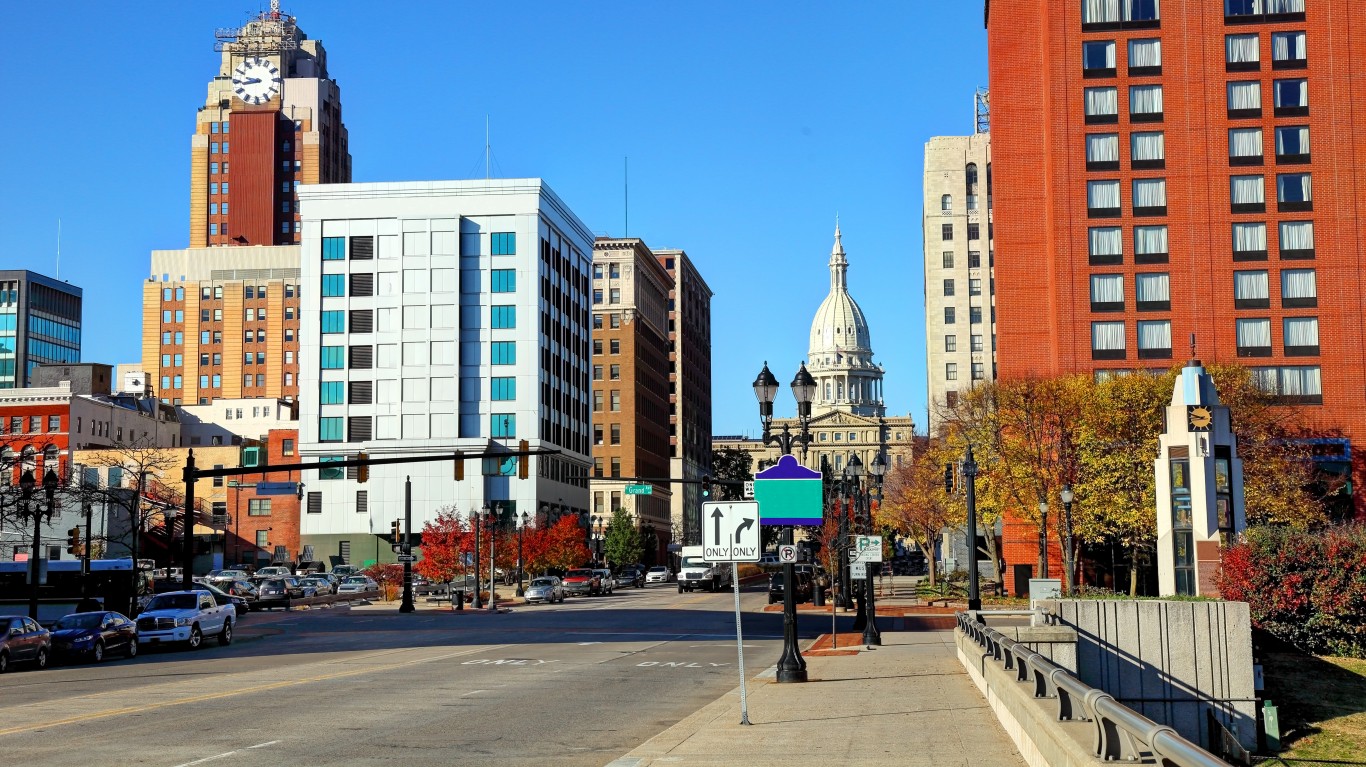
19. Lansing, Michigan
> Violent crime rate in 2019: 1,104 per 100,000 people (1,313 total)
> Total homicides reported in 2019: 12
> 2019 poverty rate: 26.1%
> 2019 annual unemployment rate: 5.0%
> 2019 population: 118,953
Lansing, Michigan, is one of 19 cities with a violent crime rate more than triple the national rate of 367 violent crimes per 100,000 residents. The city has the seventh highest rate of rape in the nation, at 118 rapes per 100,000 residents. Nationwide, 43 rapes were reported per 100,000 people in 2019.
Areas with high violent crime rates, like Lansing, tend to also have relatively low incomes and high poverty rates. Lansing’s median annual household income of $40,325 is nearly $20,000 lower than the U.S. median. The city’s 26.1% poverty rate is much higher than the 14.1% U.S. poverty rate.

18. Wichita, Kansas
> Violent crime rate in 2019: 1,141 per 100,000 people (4,451 total)
> Total homicides reported in 2019: 35
> 2019 poverty rate: 16.2%
> 2019 annual unemployment rate: 3.6%
> 2019 population: 390,080
Wichita, Kansas, reported much higher rates of all four categories of violent crime — murder, rape, robbery, and aggravated assault — than the U.S. as a whole. As is the case nationwide, the vast majority of Wichita’s 4,451 violent crimes in 2019 were aggravated assaults. The city reported 3,588 aggravated assaults, or 920 per 100,000 residents, the 12th highest rate of any large U.S. city.
Wichita also has the 11th highest rate of property crime, which includes burglary and theft, with 5,322 reported property crimes per 100,000 people. The U.S. property crime rate is less than half that, at 2,110 per 100,000.
17. New Orleans, Louisiana
> Violent crime rate in 2019: 1,145 per 100,000 people (4,516 total)
> Total homicides reported in 2019: 121
> 2019 poverty rate: 24.6%
> 2019 annual unemployment rate: 4.9%
> 2019 population: 394,498
New Orleans, Louisiana, has the 17th highest violent crime rate of any major American city, with 1,145 incidents per 100,000 people. Yet it has even more outsized rates of both homicide and rape.
The murder rate in New Orleans is the seventh highest of any U.S. city, at 31 homicides per 100,000 residents, over six times the U.S. murder rate. The city also reported the second highest rate of rape in the nation, with 196 rapes per 100,000 residents — nearly five times the national rate of 43 per 100,000.
[in-text-ad-2]

16. Rockford, Illinois
> Violent crime rate in 2019: 1,174 per 100,000 people (1,711 total)
> Total homicides reported in 2019: 14
> 2019 poverty rate: 22.6%
> 2019 annual unemployment rate: 6.8%
> 2019 population: 145,719
Rockford, Illinois, has one of the highest violent crime rates in the nation, at 1,174 per 100,000 people. The city’s murder rate of 10 homicides per 100,000 is nearly double the national rate, and its aggravated assaults rate of 885 incidents per 100,000 is well more than triple the national rate of 250 aggravated assaults per 100,000.
Areas with high shares of violent crime often also face other challenges, such as low incomes and high poverty and unemployment. Rockford had the third highest annual unemployment rate of any city in 2019, at 6.8%. The national unemployment rate was 3.7%.

15. Anchorage, Alaska
> Violent crime rate in 2019: 1,245 per 100,000 people (3,581 total)
> Total homicides reported in 2019: 32
> 2019 poverty rate: 9.2%
> 2019 annual unemployment rate: 5.1%
> 2019 population: 287,731
Anchorage is one of just 15 U.S. cities with a violent crime rate of more than 1,200 incidents per 100,000 people. The majority of the city’s violent crimes were aggravated assaults, at 830 assaults per 100,000 residents. Anchorage has the third highest rate of rape in the nation, reporting 188 rapes per 100,000 residents, well above the nationwide rate of 43 per 100,000.
Unlike nearly all of the other cities on this list, Anchorage residents tend to be financially well off. The typical household in the city earns over $83,000 annually, and Anchorage has a 9.2% poverty rate — well below the 14.1% U.S. poverty rate.
[in-text-ad]

14. Oakland, California
> Violent crime rate in 2019: 1,272 per 100,000 people (5,520 total)
> Total homicides reported in 2019: 78
> 2019 poverty rate: 17.6%
> 2019 annual unemployment rate: 3.4%
> 2019 population: 434,036
Across the U.S., aggravated assault is the most common violent crime, with 250 reported offences per 100,000 people. Robbery is the second most common, though it is well behind aggravated assault, with 82 incidents per 100,000 people nationwide. In Oakland, however, there were more robberies — 659 per 100,000 — than aggravated assaults, at 509 per 100,000.
Oakland, which has the second highest rate of robbery of any major city, also reported outsized shares of several nonviolent crimes. The city led the nation with 1,161 car thefts per 100,000 residents, which is more than five times the U.S. rate. It also ranked third with 4,660 thefts per 100,000.
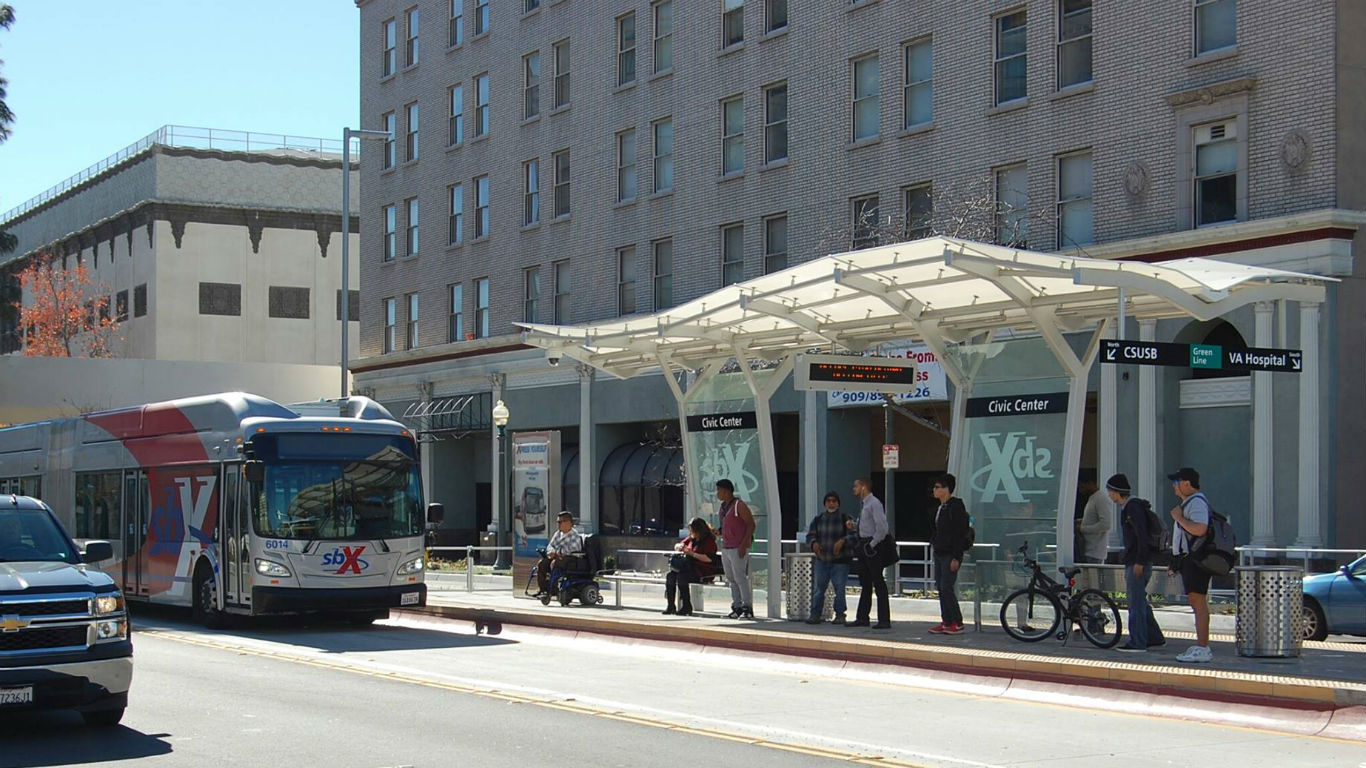
13. San Bernardino, California
> Violent crime rate in 2019: 1,319 per 100,000 people (2,858 total)
> Total homicides reported in 2019: 46
> 2019 poverty rate: 28.4%
> 2019 annual unemployment rate: 4.8%
> 2019 population: 216,715
Nationwide, there were 82 robberies reported for every 100,000 Americans in 2019. In San Bernardino, California, there were 418 robberies per 100,000, the fifth highest rate among all major cities.
Like many other cities with high crime rates, San Bernardino has a relatively high poverty rate. The city’s 28.4% poverty rate is more than double the nationwide poverty rate. San Bernardino also has a relatively high unemployment rate, at 4.8%.
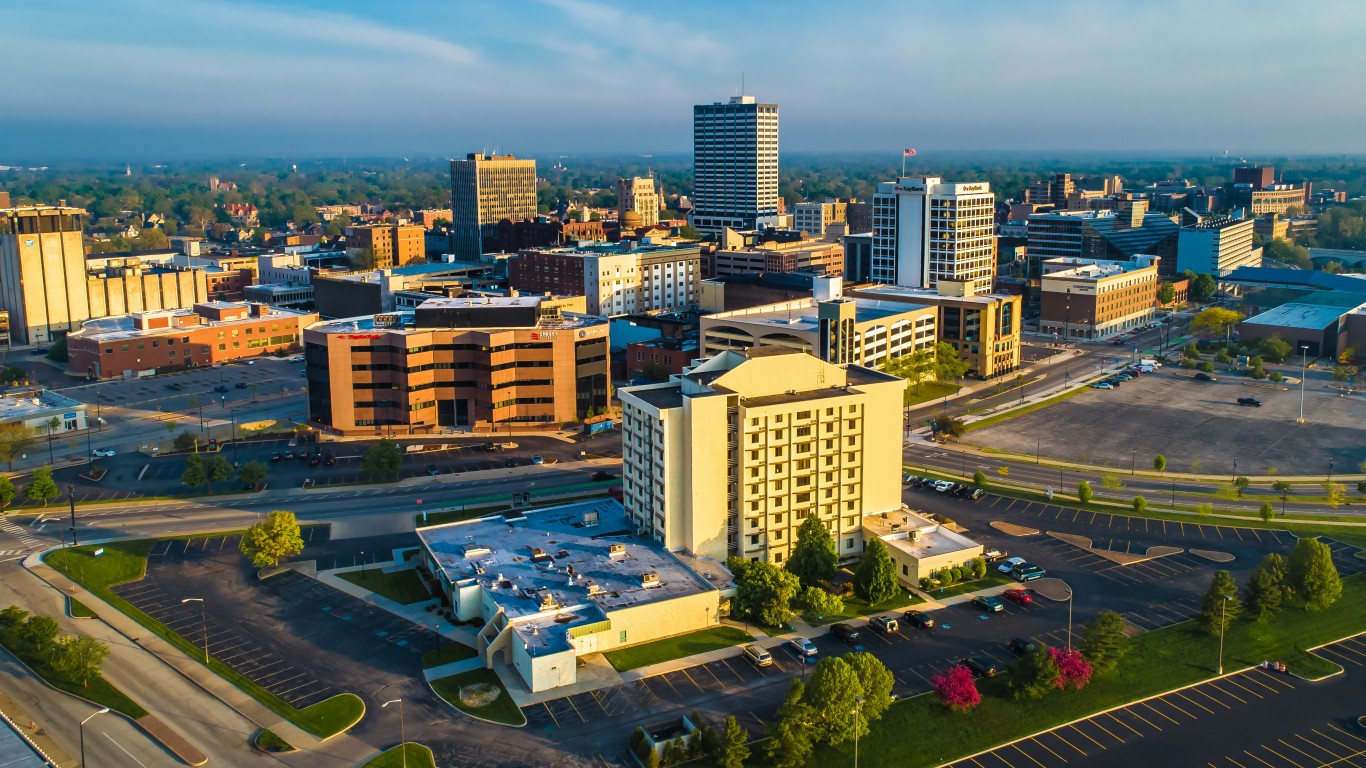
12. South Bend, Indiana
> Violent crime rate in 2019: 1,331 per 100,000 people (1,357 total)
> Total homicides reported in 2019: 14
> 2019 poverty rate: 23.8%
> 2019 annual unemployment rate: 4.0%
> 2019 population: 101,944
South Bend is the most dangerous large city in Indiana. There were 1,331 violent crimes in the city for every 100,000 people in 2019, over three and a half times the reported crime rate nationwide. The murder rate in the city of 14 incidents per 100,000 people is nearly triple the national homicide rate, and the aggravated assault rate of 1,001 incidents per 100,00 people is four times the national rate.
South Bend’s high rates of violence have continued into 2020, prompting some residents to demand more street lights and security cameras. City officials, including the mayor and chief of police, have acknowledged these requests and are taking steps to address them.
[in-text-ad-2]

11. Milwaukee, Wisconsin
> Violent crime rate in 2019: 1,332 per 100,000 people (7,874 total)
> Total homicides reported in 2019: 97
> 2019 poverty rate: 26.6%
> 2019 annual unemployment rate: 4.5%
> 2019 population: 590,923
Milwaukee ranks as the 11th most dangerous large city in the United States and the sixth most dangerous in the Midwest. Nearly 100 murders were committed in Milwaukee in 2019, or 16 for every 100,000 people — more than three times the national homicide rate of 5 per 100,000.
Crime rates tend to be higher in lower-income areas, and Milwaukee is one of the poorest cities in the country. Most households in the city earn about $40,000 a year or less — $20,000 less than the national median household income — and more than one-quarter of all residents live below the poverty line, compared to 14.1% of all Americans.

10. Albuquerque, New Mexico
> Violent crime rate in 2019: 1,352 per 100,000 people (7,596 total)
> Total homicides reported in 2019: 84
> 2019 poverty rate: 17.6%
> 2019 annual unemployment rate: 4.4%
> 2019 population: 561,920
Albuquerque’s violent crime rate of 1,352 incidents per 100,000 people is the 10th highest of all large cities tracked by the FBI. Other crimes that are not included in the violent crime rate are also far more common in Albuquerque than they are in much of the rest of the country. For example, there were 965 motor vehicle thefts in the city for every 100,000 people in 2019, the seventh highest car theft rate among large U.S. cities and more than four times higher than the national motor vehicle theft rate of 220 per 100,000.
[in-text-ad]

9. Stockton, California
> Violent crime rate in 2019: 1,397 per 100,000 people (4,380 total)
> Total homicides reported in 2019: 34
> 2019 poverty rate: 20.5%
> 2019 annual unemployment rate: 6.8%
> 2019 population: 313,604
With 1,397 violent crimes for every 100,000 people in 2019, Stockton ranks as the most dangerous city in California and the western United States. There were a total of over 3,000 aggravated assaults reported in the city in 2019 and 1,158 robberies — more than several other cities home to over twice as many people as Stockton.
Crime is often higher in areas with limited economic opportunity. In Stockton, 6.8% of the labor force was unemployed in 2019, well above the comparable 3.7% national unemployment rate.
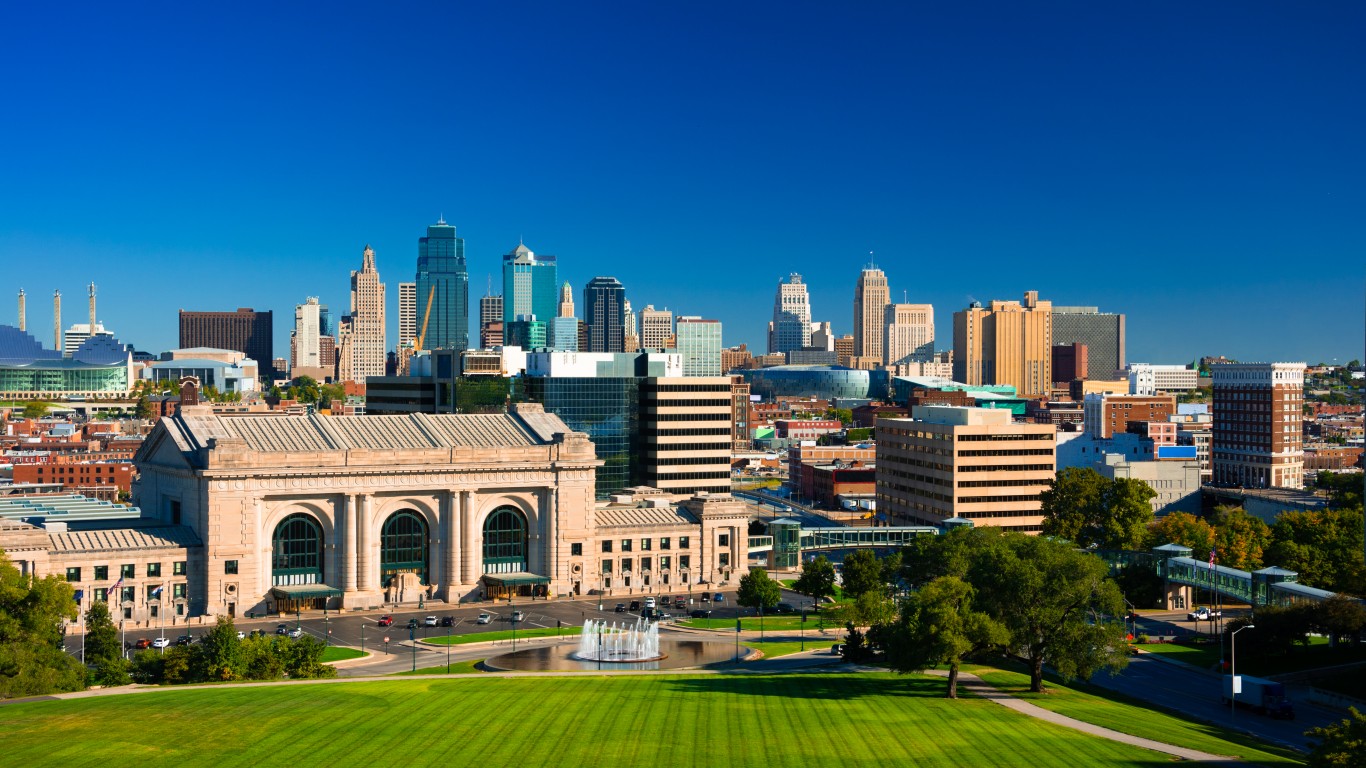
8. Kansas City, Missouri
> Violent crime rate in 2019: 1,431 per 100,000 people (7,099 total)
> Total homicides reported in 2019: 150
> 2019 poverty rate: 16.5%
> 2019 annual unemployment rate: 3.6%
> 2019 population: 495,964
Kansas City is one of three cities in Missouri to rank among the 10 most dangerous cities in the United States. The city’s murder rate of 30 incidents for every 100,000 people is six times higher than the national homicide rate. Aggravated assault — the most common violent offense both in Kansas City and across the country — is also far more common in Kansas City than it is nationwide. There were 1,040 reported cases of aggravated assault for every 100,000 people in the city in 2019, more than four times the national aggravated assault rate of 250 incidents per 100,000.
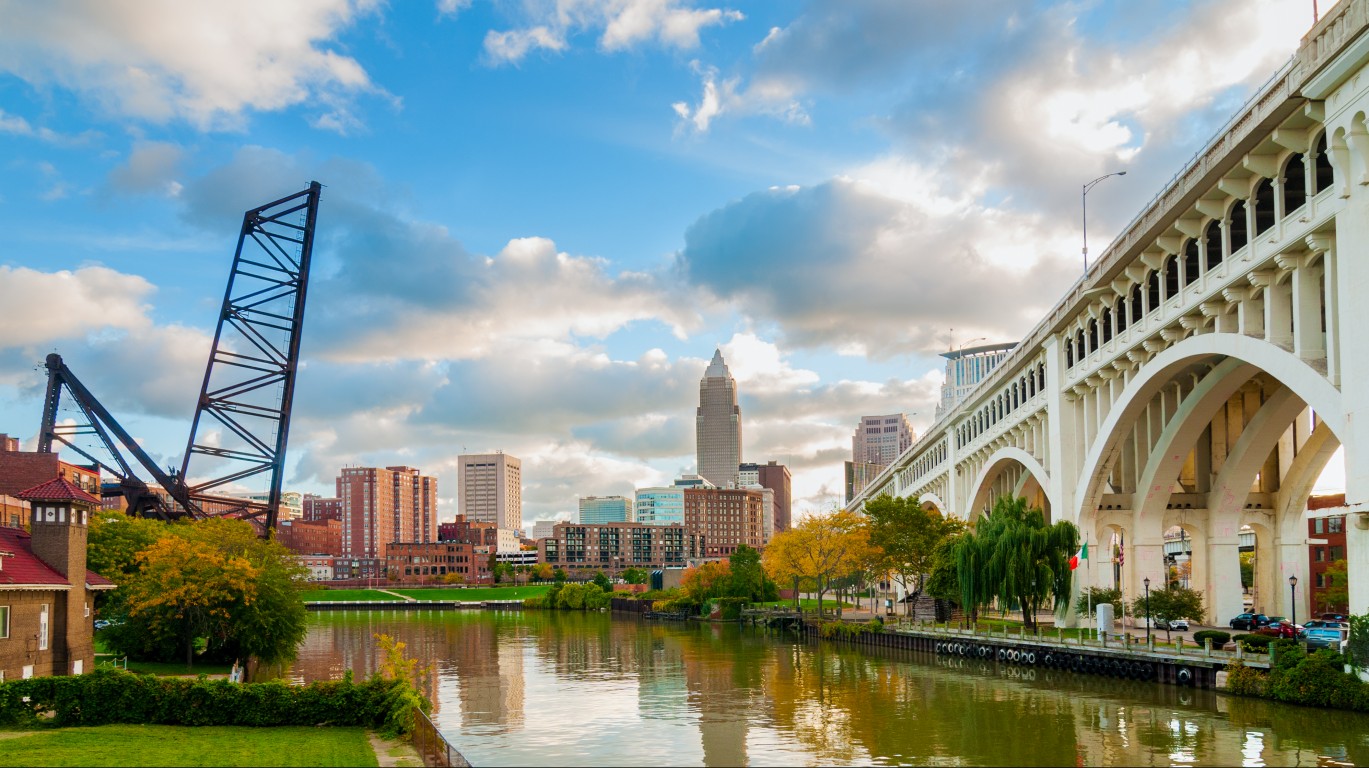
7. Cleveland, Ohio
> Violent crime rate in 2019: 1,517 per 100,000 people (5,791 total)
> Total homicides reported in 2019: 92
> 2019 poverty rate: 34.6%
> 2019 annual unemployment rate: 5.2%
> 2019 population: 381,829
Half of the most dangerous large U.S. cities are located in the Midwest — and Cleveland is one of them. There were 1,517 violent crimes reported in Cleveland for every 100,000 residents in 2019, more than four times the national violent crime rate.
Violence tends to be more common in lower-income areas, and Cleveland is one of the poorest cities in the country. Nearly 35% of the city’s population lives below the poverty line, more than double the 14.1% national poverty rate.
[in-text-ad-2]
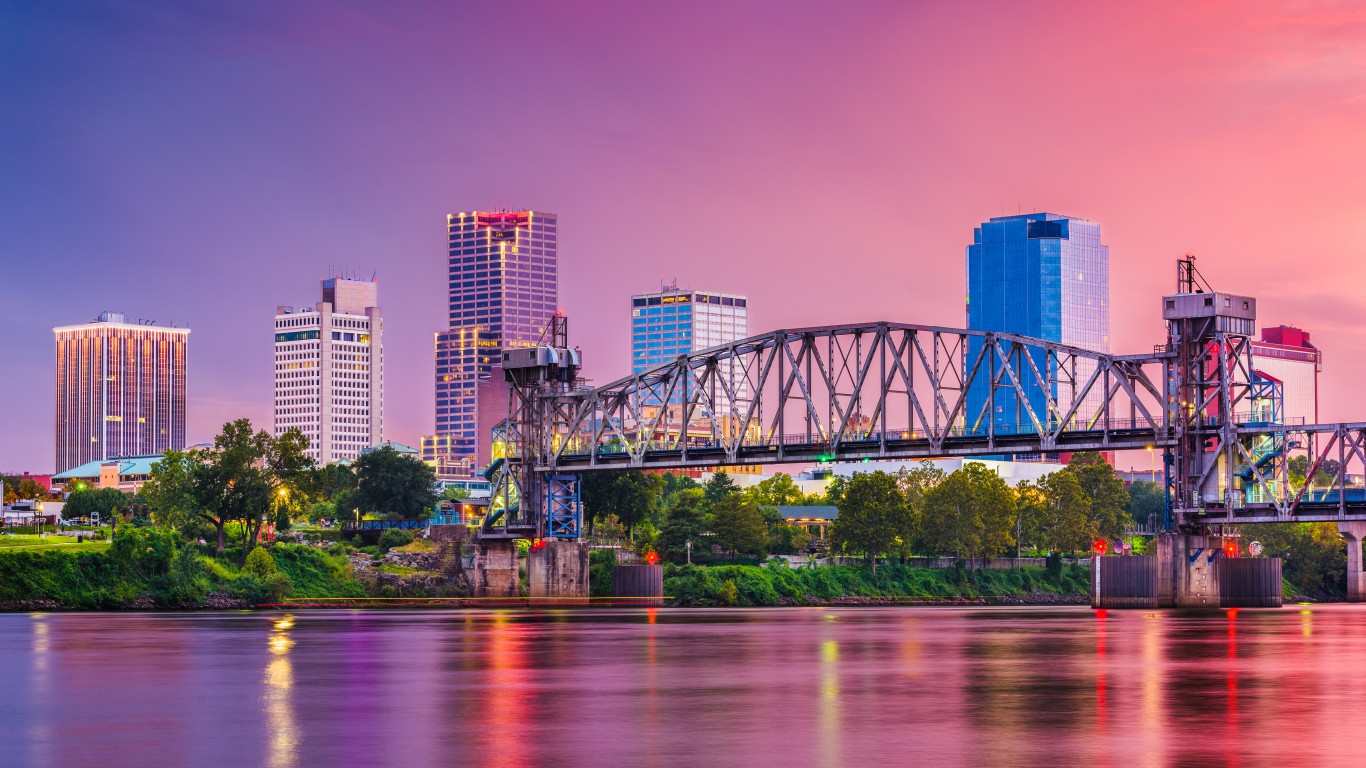
6. Little Rock, Arkansas
> Violent crime rate in 2019: 1,517 per 100,000 people (3,009 total)
> Total homicides reported in 2019: 38
> 2019 poverty rate: 17.4%
> 2019 annual unemployment rate: 3.3%
> 2019 population: 198,382
Little Rock, the capital of Arkansas, ranks as the most dangerous city in the state and also one of the most dangerous nationwide. Driven primarily by incidents of aggravated assault, Little Rock has a violent crime rate of 1,517 incidents for every 100,000 people, compared to the national rate of 367 per 100,000.
Little Rock also has a far higher than average property crime rate. There were 6,122 property crimes such as burglary and motor vehicle theft in the city for every 100,000 people in 2019 — nearly three times the national property crime rate of 2,110 per 100,000.
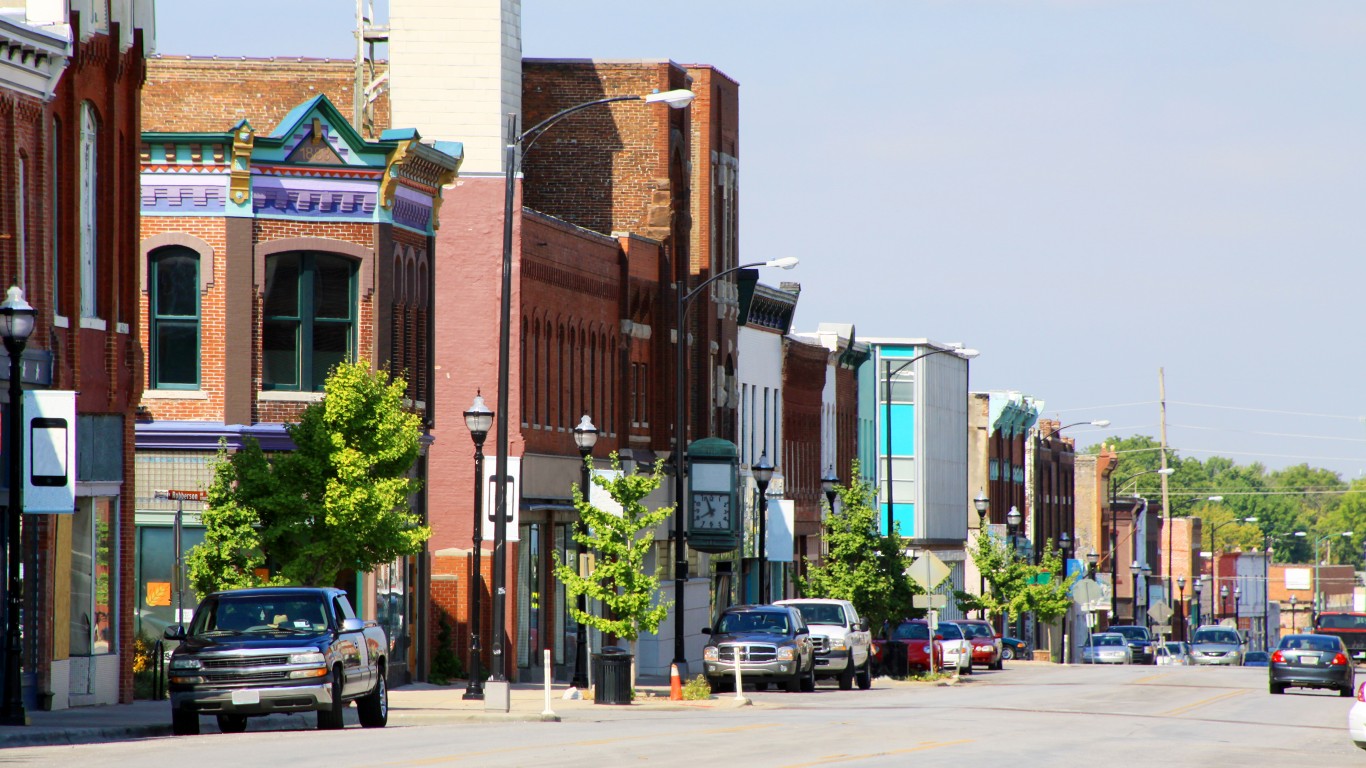
5. Springfield, Missouri
> Violent crime rate in 2019: 1,519 per 100,000 people (2,571 total)
> Total homicides reported in 2019: 11
> 2019 poverty rate: 24.8%
> 2019 annual unemployment rate: 2.8%
> 2019 population: 169,235
Springfield is one of two large cities in Missouri to rank among the top five most dangerous cities nationwide. There were 1,519 violent crimes reported in Springfield in 2019 for every 100,000 people.
While violent crimes like rape, robbery, and aggravated assault are far more common in Springfield than they are nationwide, the city’s murder rate is well below that of nearly every other city on this list and in line with the national average. There were 6 murders in the city for every 100,000 people in 2019, compared to 5 per 100,000 nationwide.
[in-text-ad]
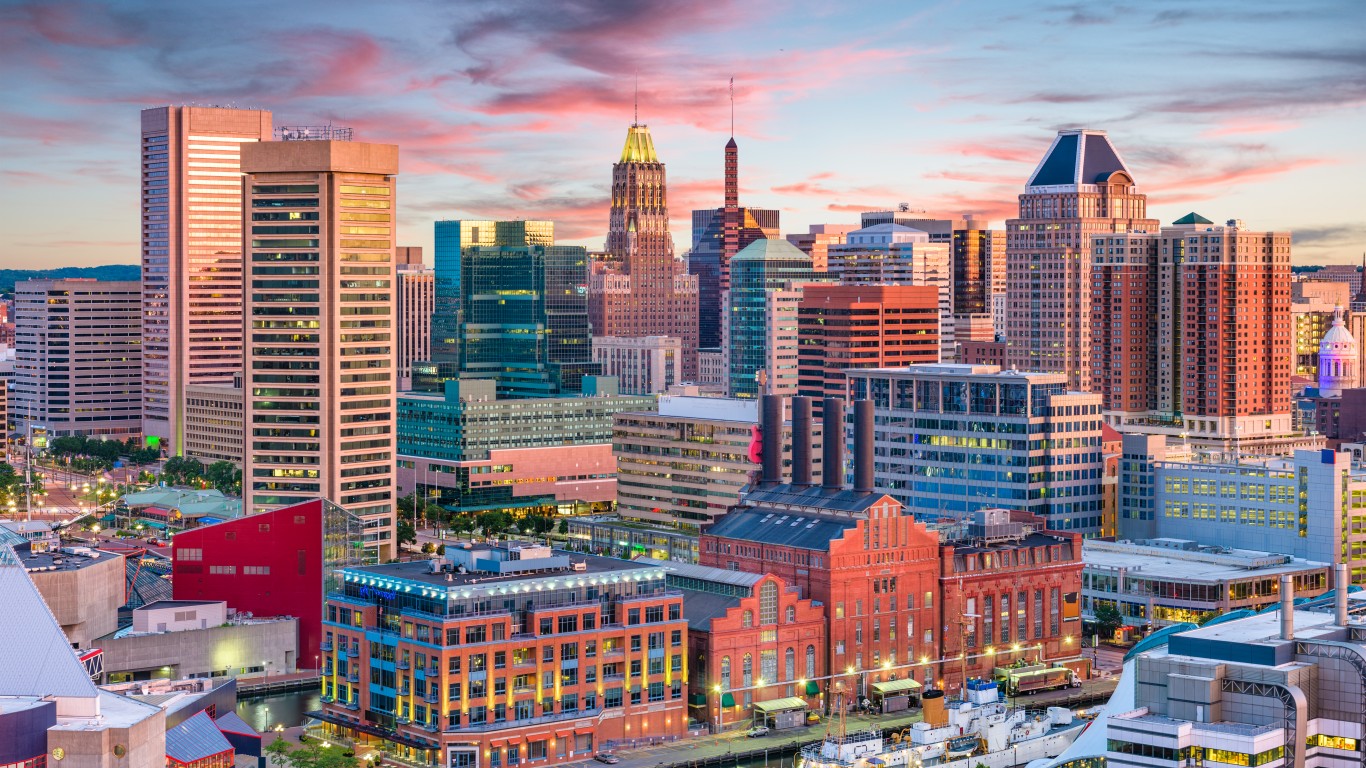
4. Baltimore, Maryland
> Violent crime rate in 2019: 1,859 per 100,000 people (11,101 total)
> Total homicides reported in 2019: 348
> 2019 poverty rate: 21.8%
> 2019 annual unemployment rate: 5.1%
> 2019 population: 597,239
There were 348 murders committed in Baltimore in 2019, or 58 for every 100,000 people — the second highest homicide rate of any large U.S. city, trailing only St. Louis. For context, there were only 5 murders for every 100,000 people nationwide last year. Murders have continued to surge in the city, and 2020 marks the sixth year in a row with more than 300 homicides in the city.
Violence tends to be more concentrated in lower-income areas with limited economic opportunity. In Baltimore, 21.8% of the population lives below the poverty line, and 5.1% of the labor force is unemployed, compared to the 14.1% national poverty rate and 3.7% national annual unemployment rate.
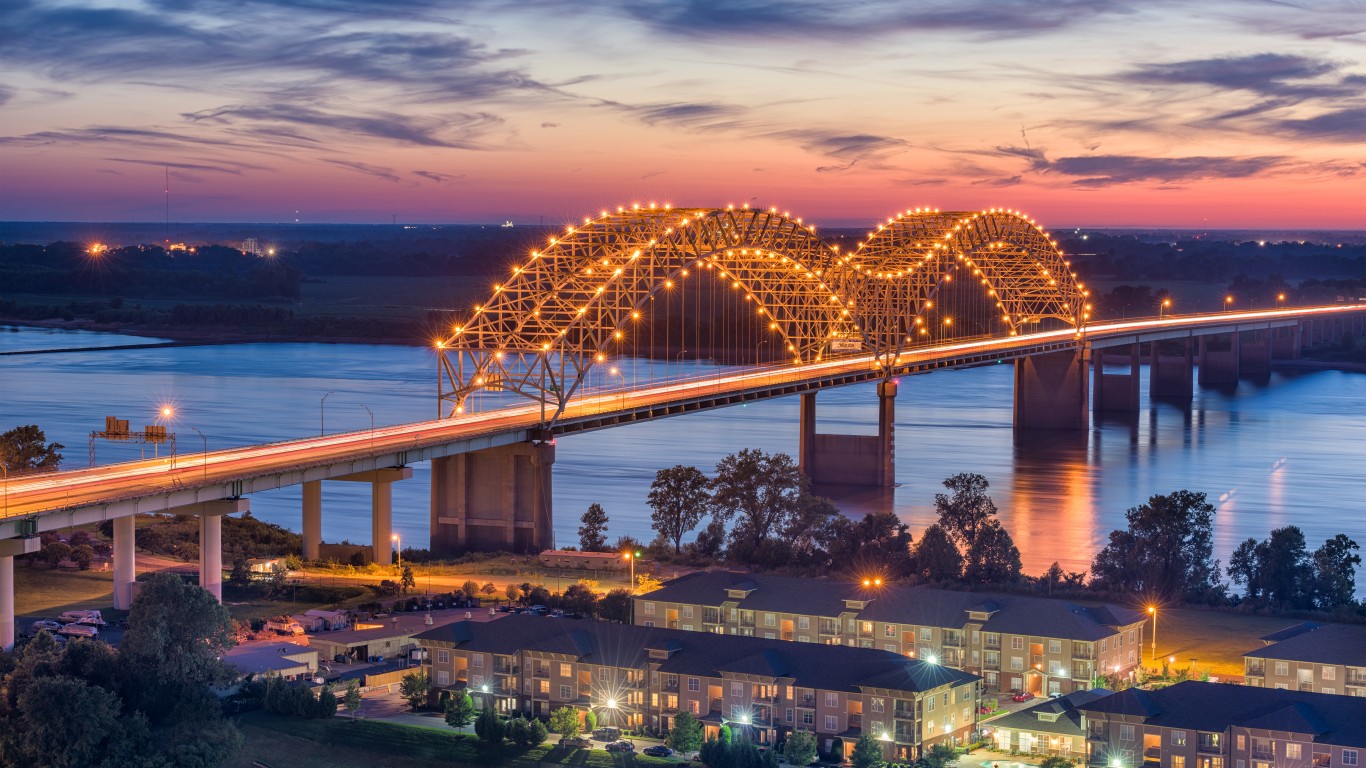
3. Memphis, Tennessee
> Violent crime rate in 2019: 1,901 per 100,000 people (12,367 total)
> Total homicides reported in 2019: 190
> 2019 poverty rate: 26.8%
> 2019 annual unemployment rate: 4.4%
> 2019 population: 650,410
Two of the five cities with the highest violent crime rates are located in the South — and Memphis is one of them. There were 12,367 combined cases of rape, robbery, aggravated assault, and murder in the city in 2019 — or 1,901 violent crimes for every 100,000 people.
As is the case in many cities on this list, violence is only getting worse in Memphis. So far in 2020, there has been a record number of murders, surpassing the previous high of 226 — and there are still three months left in the year. In 2019, 194 homicides were reported in Memphis.
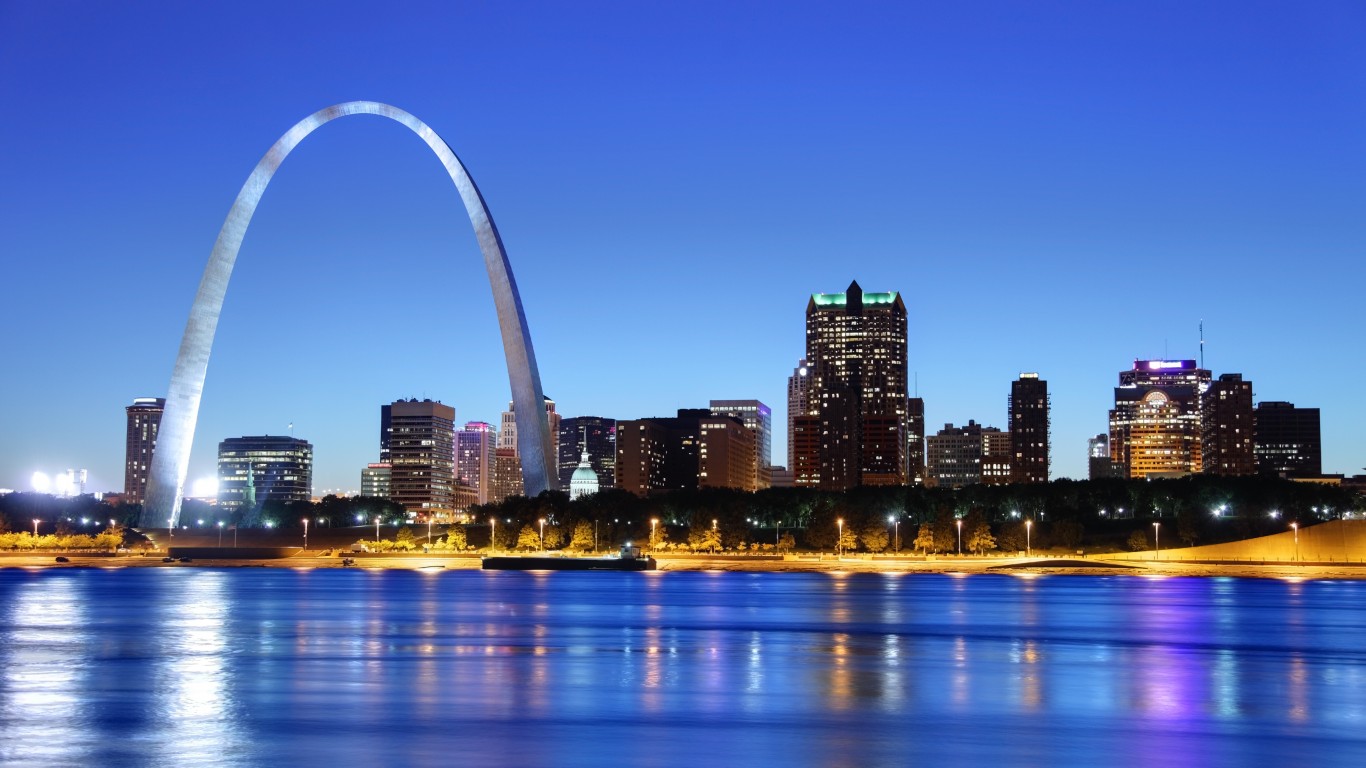
2. St. Louis, Missouri
> Violent crime rate in 2019: 1,927 per 100,000 people (5,792 total)
> Total homicides reported in 2019: 194
> 2019 poverty rate: 24.2%
> 2019 annual unemployment rate: 3.9%
> 2019 population: 300,521
St. Louis, Missouri, is one of only three large cities to report more than 1,900 violent crimes for every 100,000 people in 2019. The city’s murder rate of 65 homicides for every 100,000 people is about 13 times higher than the national murder rate of 5 per 100,000 — and it does not seem as if it will improve any time soon. In the nine months of 2020, St. Louis reported more homicides than it did in all of 2019, and the year is on track to break the city’s all time high homicide rate record set in 1993, when there were 70 homicides per 100,000 people.
Some local experts link the city’s high homicide rate to poverty. An estimated, 24.2% of the city’s population lives below the poverty line, compared to 14.1% of Americans nationwide.
[in-text-ad-2]
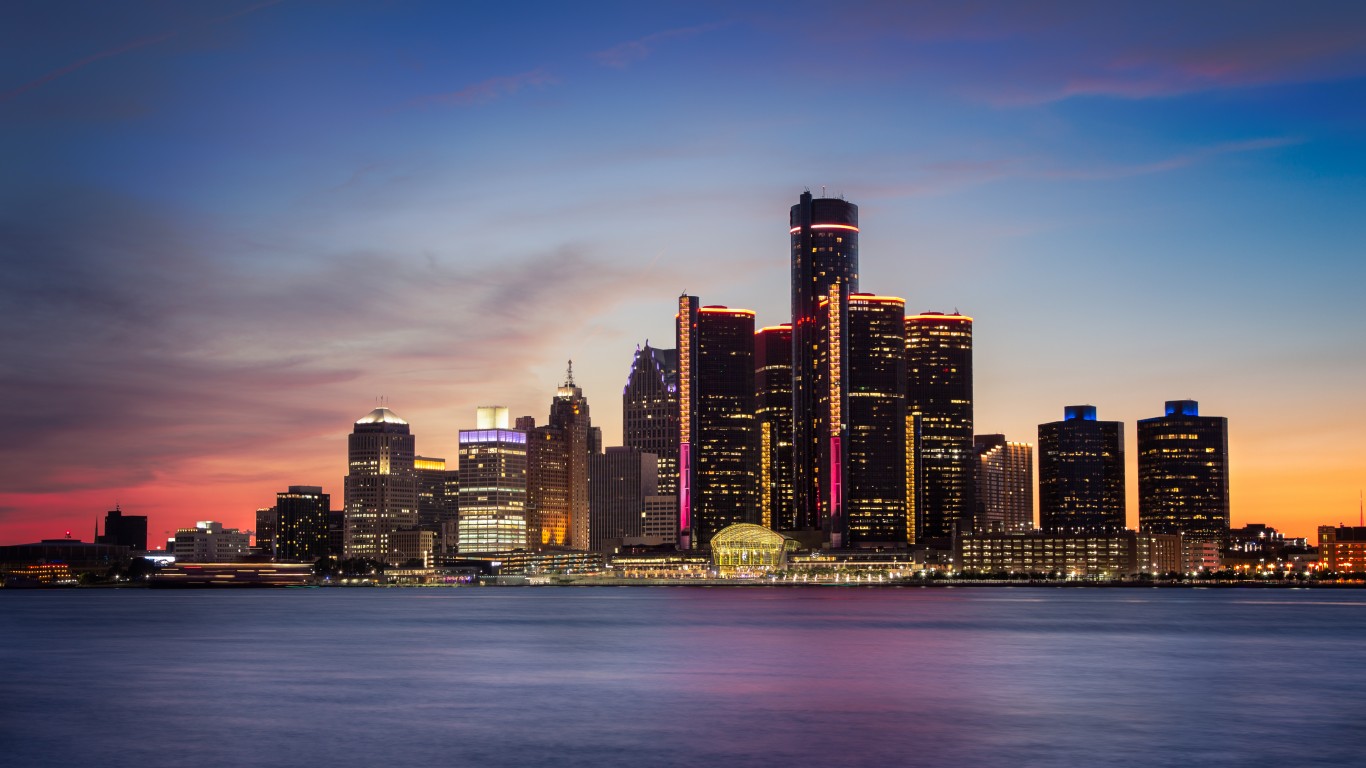
1. Detroit, Michigan
> Violent crime rate in 2019: 1,965 per 100,000 people (13,040 total)
> Total homicides reported in 2019: 275
> 2019 poverty rate: 36.4%
> 2019 annual unemployment rate: 8.8%
> 2019 population: 663,502
Detroit ranks as the most dangerous city in the United States, with 13,040 violent crimes reported in 2019 — or 1,965 for every 100,000 people. Aggravated assaults account for the largest share of violent crimes in the city, followed by robberies.
Violence tends to be more concentrated in lower-income areas with limited economic opportunity. In Detroit, 36.4% of the population lives below the poverty line, and 8.8% of the labor force is unemployed — compared to the national 14.1% poverty rate and 3.7% annual jobless rate.
Methodology
To determine the 25 most dangerous cities in America, 24/7 Wall St. reviewed violent crime figures in cities with at least 100,000 people from the FBI’s 2019 Uniform Crime Report. Violent crime includes murder, non-negligent manslaughter, rape, robbery, and aggravated assault, and property crime includes burglaries, larceny, and motor vehicle theft. Violent crime figures were adjusted for population using data from the FBI.
Annual unemployment rates for 2019 came from the Bureau of Labor Statistics (BLS). Median household income, poverty rates, and the percentage of households earning less than $10,000 a year came from the U.S. Census Bureau’s American Community Survey (ACS) and are five-year averages for the period 2014 to 2018.
100 Million Americans Are Missing This Crucial Retirement Tool
The thought of burdening your family with a financial disaster is most Americans’ nightmare. However, recent studies show that over 100 million Americans still don’t have proper life insurance in the event they pass away.
Life insurance can bring peace of mind – ensuring your loved ones are safeguarded against unforeseen expenses and debts. With premiums often lower than expected and a variety of plans tailored to different life stages and health conditions, securing a policy is more accessible than ever.
A quick, no-obligation quote can provide valuable insight into what’s available and what might best suit your family’s needs. Life insurance is a simple step you can take today to help secure peace of mind for your loved ones tomorrow.
Click here to learn how to get a quote in just a few minutes.
Thank you for reading! Have some feedback for us?
Contact the 24/7 Wall St. editorial team.
 24/7 Wall St.
24/7 Wall St.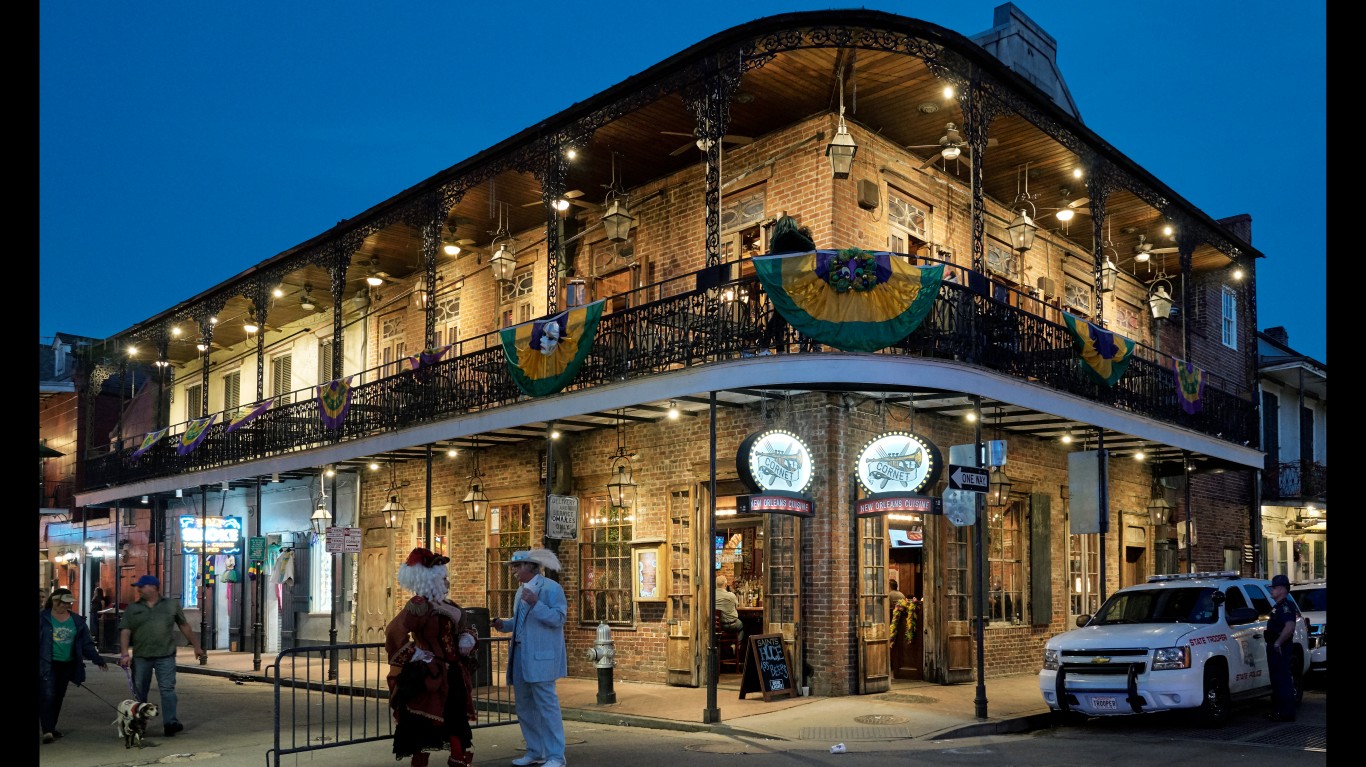
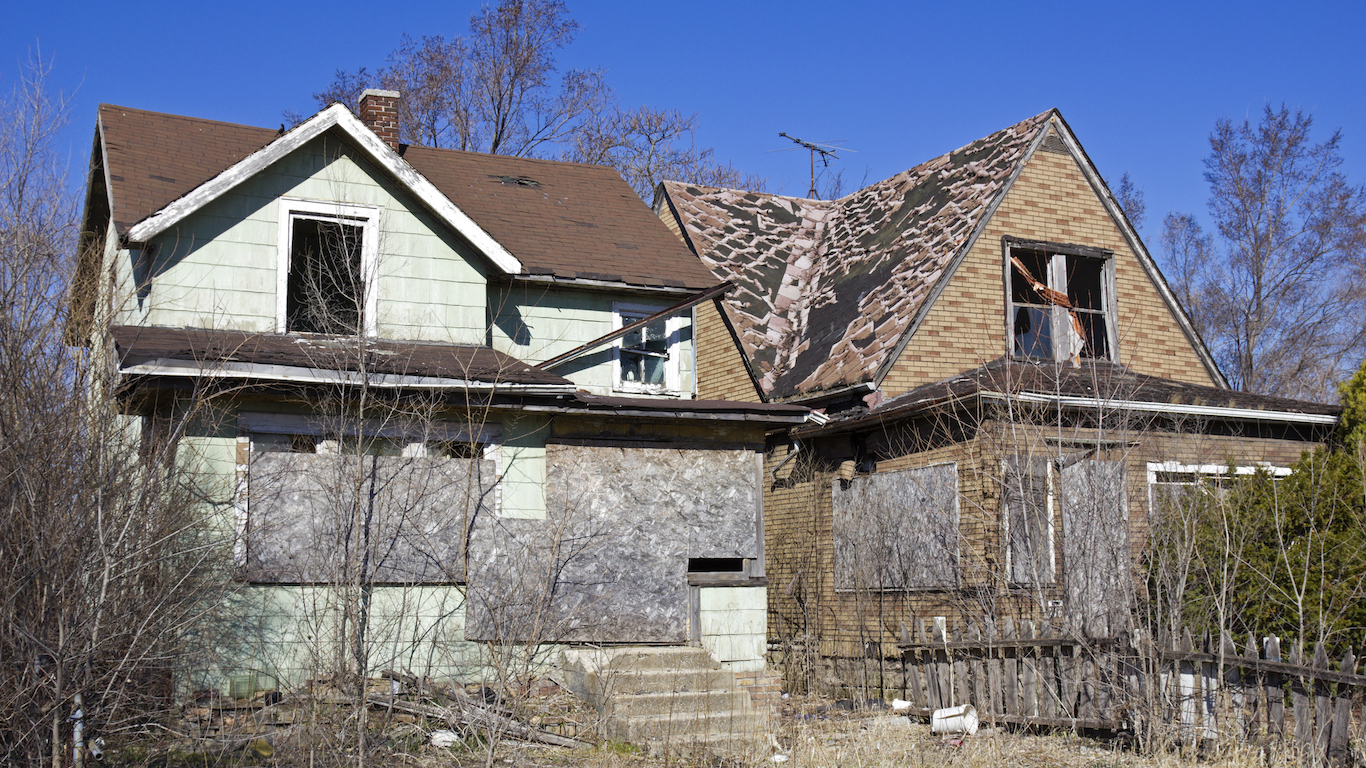 24/7 Wall St.
24/7 Wall St.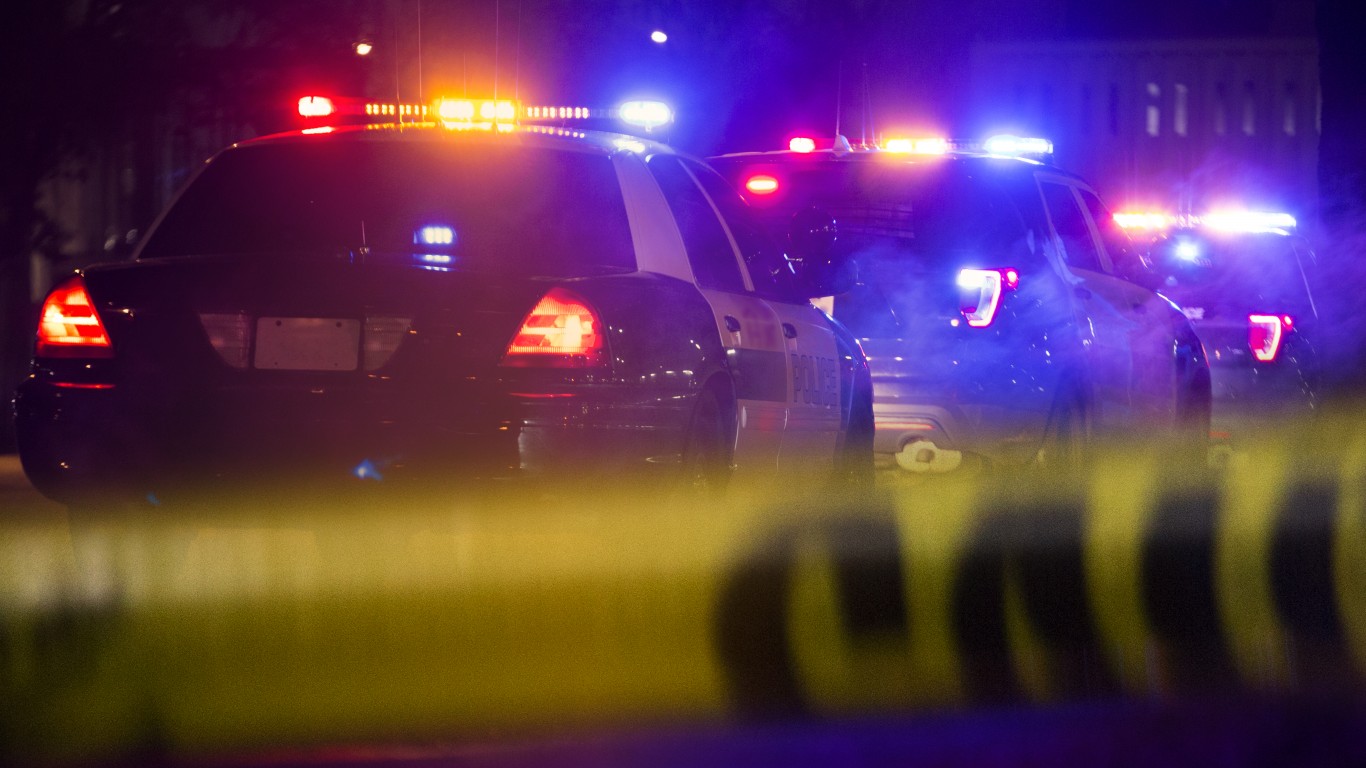 24/7 Wall St.
24/7 Wall St.
